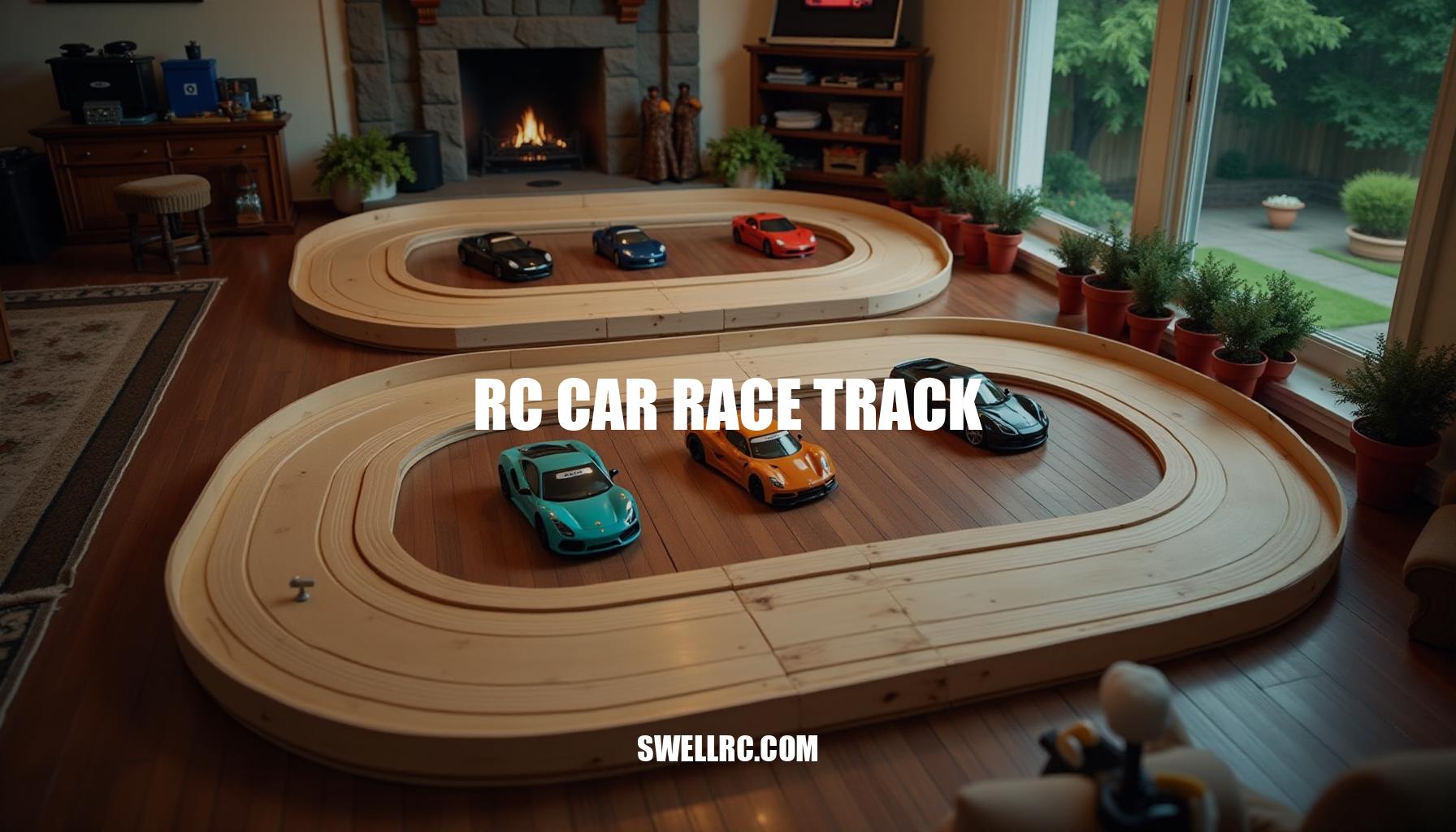How to Build an RC Car Race Track at Home
I still remember the first time I stood beside a proper RC car race track—the buzz of motors, the smell of hot tires, and the way a well-placed chicane could make an average setup feel heroic. An RC car race track is a purpose-built course where layout and surface amplify (or expose) a car’s strengths, and it’s just as important to lap times as the electronics and tires you bolt on. From tight indoor carpet to sun-baked outdoor asphalt, from loamy dirt to slick drift layouts, every track changes how you brake, rotate, and apply power in your RC racing adventures.
If you’re hunting for a place to run, start with rc race tracks near me to find both indoor RC tracks perfect for controlled remote control racing and outdoor RC tracks where you can push the limits on dirt and asphalt. Whether you’re into RC drift or prefer the thrill of dirt track RC, understanding race track design can elevate your performance and enjoyment. Stick with me—I’ll show you how different track types drive, how to build your own, and which RC cars shine where.
Types of RC Car Race Tracks and What Makes Them Unique
After hours of testing various RC track layouts, I realized each track type really has its own personality—some reward razor-clean lines, while others demand throttle bravery and quick hands. Understanding these differences can help you select the perfect car and adapt your racing style to the surface for optimal performance.
| Track Type | Surface Material | Ideal RC Car Type | Typical Racing Style |
|---|---|---|---|
| Indoor Carpet Circuit | Carpet | 1/10 touring cars, 1/12 pan cars | Precision, high-grip, clean lines |
| Outdoor Asphalt Road Course | Asphalt | 1/10 touring, GT, F1 electric | High-speed, smooth inputs, tire management |
| Dirt Off-Road Track | Loamy dirt, mixed clay | 1/10 buggies, short course trucks | Jumps, variable grip, rhythm sections |
| Dirt Oval | Packed dirt or prepared clay | Late models, sprint cars | Left-turn throttle control, momentum racing (learn more) |
| Drift Track | Polished concrete, P-tile, epoxy | RWD drift chassis | Controlled oversteer, style and angle (explore) |
| High-Bite Clay Track | Prepared clay | 1/10 buggy, stadium truck | Corner speed, line discipline; rewards refined setups and professional RC cars |
Surface matters tremendously in how your RC car handles. For example, the contrast between asphalt vs carpet vs clay surfaces influences traction and handling drastically. Asphalt tracks heat tires quickly and punish overdriving mistakes, demanding smooth input and tire management on outdoor RC tracks.
Conversely, indoor carpet tracks offer tons of grip but magnify setup errors, requiring precision driving on indoor RC tracks.
Clay surfaces, whether on a dirt oval or a high-bite clay track, can feel magical when properly prepped—offering consistent bite and predictable slides as the racing groove forms. This makes tune-ups and setting adjustments on rc dirt oval and high-bite clay tracks critical for success. Lastly, dedicated RC drift tracks like polished concrete or epoxy challenge drivers to master throttle and angle for controlled oversteer and style.
Knowing your RC track layout and the interplay of surface material with car type is key to maximizing performance and enjoyment. Matching your driving style and vehicle to the right track surface unlocks faster lap times and more thrilling races.
How to Build Your Own RC Car Race Track
Designing a home or club track is addicting—it’s like solving a driving puzzle you can rearrange any weekend. If you’re wondering how to build an rc car race track, it starts with thoughtful layout planning. First, measure and map your usable space including walkway clearances, marshal zones, and a safe driver’s stand area.
Next, sketch the flow of your track by balancing straights, sweepers, hairpins, and rhythm sections to create a course that is learnable but hard to master. When considering RC track design, pay particular attention to elevation changes which add complexity and excitement to the driving experience.
Choosing the right RC car track materials is essential: use carpet rolls or EVA tiles for indoor tracks, or compacted dirt or clay mix with proper drainage and shade for outdoor tracks. Building the base involves leveling, tamping, and securing seams, tacking carpet edges, and watering and packing dirt/clay to ensure consistency.
Safety and flow are enhanced by adding appropriate barriers such as corrugated pipes, pool noodles, and track dots, while avoiding hard edges. These barriers must include marshal access points to maintain smooth race operations.
The pit area is another important feature—set up folding tables, power strips, and lighting. For timing, start simple with phone-based systems before upgrading to transponders.
Once built, test and tune by moving apex cones, widening tight spots, tweaking jump faces, and ensuring clear sightlines from the driver’s stand. Consistent maintenance like sweeping and vacuuming carpets, watering and rolling dirt tracks, patching clay, and repairing or replacing worn barriers will keep the track race-ready year-round.
Here is a step-by-step summary integrating key elements of RC track construction:
- Measure and map: usable space, walkways, marshal zones, driver’s stand
- Sketch the flow: straights, sweepers, hairpins, rhythm sections; plan elevation changes
- Choose surface materials: carpet rolls, EVA tiles, compacted dirt, clay mix
- Build base: level, tamp, secure seams, water and pack dirt/clay
- Add barriers: corrugated pipe, pool noodles, track dots; create safe marshal zones
- Setup pits and timing: tables, power, lighting; start with phone timing
- Test and tune: adjust cones, widen turns, tweak jumps, ensure clear sightlines
- Plan maintenance: sweep/vacuum, water and roll dirt, patch surfaces, replace barriers
By following these guidelines integrating RC track design, proper RC car track materials, strategic layout planning, handling elevation changes, installing safe barriers, organizing an efficient pit area, and committing to regular maintenance, you’ll create a track that is challenging, safe, and fun for all skill levels.
Performance, Power, and the Cars Built to Conquer Tracks
Matching the car to the track is key to unlocking faster lap times in RC performance. Whether you’re racing on carpet, asphalt, or clay, pushing these machines to their limits reveals what truly impacts your speed. For instance, the RC F1 Nitro delivers racy open-wheel realism with blistering top speed but demands smooth throttle control on high-grip road courses.
On the other hand, the Rovan RF5 is a big-bore brawler designed for larger outdoor layouts where stability and torque dominate. If you’re stepping into serious club or series competition, professional RC car setups offer precise tolerances and a wide tuning range, essential for lap time optimization.
Several factors influence lap time beyond just the model:
- Weight distribution: A lower center of gravity improves transitions. Moving the battery fore or aft lets you tune the car’s rotation versus stability on the track.
- Suspension tuning: Adjusting spring rates and oil weights controls weight transfer. Adding a pack helps absorb big jumps, while lighter setups favor carpet grip.
- Tires and inserts: Tire compound is a crucial element—softer compounds perform better in cold or low-grip conditions, while harder ones withstand heat and longer mains. Matching insert stiffness to sidewall support fine-tunes handling.
- Drivetrain and power: Gear ratios should be adapted based on temperature and runtime needs. For nitro setups, clutch tuning and mixture settings are just as critical as an electric ESC map when it comes to performance.
| Factor | Effect on Lap Time | Key Considerations |
|---|---|---|
| Weight Distribution | Improves corner transitions | Battery position affects rotation vs stability |
| Suspension Tuning | Controls weight transfer and grip | Spring rates, oil weight, and pack addition |
| Tire Compound & Inserts | Optimizes traction and durability | Soft vs hard compounds, insert stiffness |
| Drivetrain & Power | Maximizes acceleration and control | Gear ratio, motor KV, clutch tuning, ESC mapping |
Curious about the competitive scene and potential prizes? Discover more about monetizing your passion in RC racing by starting here. Whether you prefer electric vs nitro powertrains, mastering weight distribution, suspension tuning, or dialing in clutch settings, understanding these elements leads to consistent lap time optimization and competitive advantage.
Finding RC Race Tracks Near You and Joining the Community
The fastest way to improve your skills is to run with others at rc tracks near me. Search local directories and join local RC clubs or RC leagues that host regular community meetups, such as RC drift nights. Don’t be shy—RC enthusiasts love helping new racers and creating a welcoming environment.
You’ll often encounter posted etiquette and safety rules, volunteer marshalling to keep the races flowing smoothly, and a friendly vibe across venues ranging from road courses to drift tracks.
Here’s a quick rundown of important track etiquette and safety measures to keep in mind:
- Announce when entering the track and always yield to oncoming traffic to avoid collisions.
- Marshal proactively and safely—focus on watching the cars, not just the drivers, to maintain race integrity.
- Keep LiPo batteries stored and charged safely using a pit mat, and maintain a tidy work area for everyone’s safety.
- Always ask before using traction compound and strictly follow the tire and frequency rules set by your club or league.
For a quick start at your local RC track or club, try these steps:
| Step | Action |
|---|---|
| 1 | Find a nearby club, shop track, or rc tracks near me and visit during a practice session. |
| 2 | Read the class rules and select a beginner-friendly racing class. |
| 3 | Prepare essentials like charged battery packs or tuned nitro engines, labeled equipment, and spare tires. |
| 4 | Start with practice laps, then step up to entering a novice heat for real race experience. |
| 5 | After racing, debrief with locals to tweak your setup and plan to return next week for continuous improvement. |
Most importantly, enjoy the social side of the hobby. Shared tools, setup tips, and the thrill of side-by-side racing make being part of local RC clubs and community meetups incredibly rewarding.
Conclusion: Racing Forward — Why RC Tracks Keep the Passion Alive
What hooked me wasn’t just the speed—it was the precision, the puzzle of setup, and the community racing that cheers your PB one lap and chases you the next. RC racing passion truly comes alive on tracks that cater to every style and skill level. Track diversity means each course challenges you differently: some teach you how to build a flowing layout, others demand sharp performance tuning to master the surface.
Beyond driving, the experience kindles hands-on creativity as you tweak and refine your car. Here’s what you gain from immersing yourself in these vibrant raceways:
- Track Diversity: Different tracks sharpen different skills, from cornering finesse to speed control.
- Performance Tuning: Adjustments to suspension, tires, and gearing teach you about optimizing for each unique surface.
- Hands-on Creativity: Building and modifying your RC car fosters a personal connection and deeper understanding.
- Community Racing: Racing alongside friends and rivals drives continuous improvement and sportsmanship.
- Continuous Improvement: Every lap offers lessons, pushing you to constantly evolve your technique and setup.
Once you’ve felt that rush, it’s hard to look at racing the same way again. When you’re ready to go deeper, explore formats like 1 rc racing and keep scouting rc race tracks near me to turn any free evening into a fast one.
Frequently Asked Questions
- How do you build an RC car race track at home?
Measure your space, sketch a layout that balances speed and technical sections, choose a suitable surface (carpet indoors, compacted dirt or clay outdoors), add safe barriers and marshal zones, set up a simple pit/timing area, test the flow, and plan regular maintenance. - What are the different types of RC car race tracks?
Common types include indoor carpet circuits, outdoor asphalt road courses, dirt off-road tracks with jumps, high-bite clay tracks, dirt ovals for left-turn momentum racing, and drift tracks designed for controlled oversteer. - How much does it cost to set up an RC racing track?
A small home layout can be done for roughly $200–$600 using budget barriers and carpet or compacted dirt; club-grade builds with quality carpet, timing systems, and robust barriers can range from $1,000 to several thousand depending on size and equipment. - What RC cars are best for race tracks?
Match the car to the surface and class—touring cars and pan cars excel on carpet and asphalt, buggies and stadium trucks dominate on dirt and clay, drift chassis rule slick surfaces, and specialized oval cars shine on ovals. - What surfaces work best for RC racing?
Carpet provides consistent high grip indoors; asphalt offers realism but needs tire management; well-prepared clay gives predictable traction; compacted dirt is versatile but more maintenance-heavy; drift tracks use low-grip surfaces like P‑tile or polished concrete. - Can you make money racing RC cars?
It’s possible but uncommon; prize purses, sponsorships, and content creation can offset costs for top racers, but most hobbyists race for fun, community, and personal improvement rather than profit. - Where can I find RC race tracks near me?
Use RC directories, local hobby shops, club Facebook groups, and regional forums to locate tracks and event calendars; visiting in person during practice hours is the fastest way to learn the scene.



